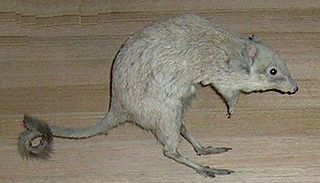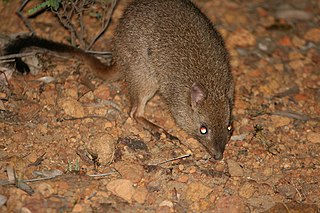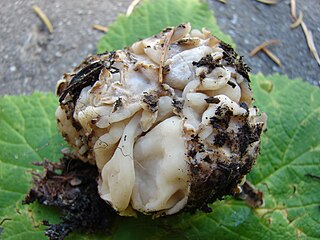
Ascomycota is a phylum of the kingdom Fungi that, together with the Basidiomycota, forms the subkingdom Dikarya. Its members are commonly known as the sac fungi or ascomycetes. It is the largest phylum of Fungi, with over 64,000 species. The defining feature of this fungal group is the "ascus", a microscopic sexual structure in which nonmotile spores, called ascospores, are formed. However, some species of the Ascomycota are asexual, meaning that they do not have a sexual cycle and thus do not form asci or ascospores. Familiar examples of sac fungi include morels, truffles, brewers' and bakers' yeast, dead man's fingers, and cup fungi. The fungal symbionts in the majority of lichens such as Cladonia belong to the Ascomycota.
An ascocarp, or ascoma, is the fruiting body (sporocarp) of an ascomycete phylum fungus. It consists of very tightly interwoven hyphae and millions of embedded asci, each of which typically contains four to eight ascospores. Ascocarps are most commonly bowl-shaped (apothecia) but may take on a spherical or flask-like form that has a pore opening to release spores (perithecia) or no opening (cleistothecia).

A truffle is the fruiting body of a subterranean ascomycete fungus, predominantly one of the many species of the genus Tuber. In addition to Tuber, over one hundred other genera of fungi are classified as truffles including Geopora, Peziza, Choiromyces, and Leucangium. These genera belong to the class Pezizomycetes and the Pezizales order. Several truffle-like basidiomycetes are excluded from Pezizales, including Rhizopogon and Glomus. Truffles are ectomycorrhizal fungi, so they are usually found in close association with tree roots. Spore dispersal is accomplished through fungivores, animals that eat fungi. These fungi have significant ecological roles in nutrient cycling and drought tolerance.

Potoroidae is a family of marsupials, small Australian animals known as bettongs, potoroos, and rat-kangaroos. All are rabbit-sized, brown, jumping marsupials and resemble a large rodent or a very small wallaby.

In fungi, a basidiocarp, basidiome, or basidioma is the sporocarp of a basidiomycete, the multicellular structure on which the spore-producing hymenium is borne. Basidiocarps are characteristic of the hymenomycetes; rusts and smuts do not produce such structures. As with other sporocarps, epigeous (above-ground) basidiocarps that are visible to the naked eye are commonly referred to as mushrooms, while hypogeous (underground) basidiocarps are usually called false truffles.

The woylie or brush-tailed bettong is a small, critically endangered, gerbil-like mammal native to forests and shrubland of Australia. A member of the rat-kangaroo family (Potoroidae), it moves by hopping and is active at night, digging for fungi to eat. It is also a marsupial and carries its young in a pouch. Once widespread, the woylie mostly died out from habitat loss and introduced predators such as foxes. It is currently restricted to two small areas in Western Australia. There are two subspecies: B. p. ogilbyi in the west, and the now-extinct B. p. penicillata in the southeast.

Gilbert's potoroo or ngilkat is Australia's most endangered marsupial, the rarest marsupial in the world, and one of the world's rarest critically endangered mammals, found in south-western Western Australia. It is a small nocturnal macropod that lives in small groups.

The northern bettong is a small, endangered, gerbil-like mammal native to forests in northeast Australia. A member of the rat-kangaroo family (Potoroidae), it moves by hopping and lives in burrows, feeding at night on roots and fungi. It is also a marsupial and carries its young in a pouch. The northern bettong is threatened by habitat loss, and is now restricted to a few small areas.

Rhizopogon is a genus of ectomycorrhizal basidiomycetes in the family Rhizopogonaceae. Species form hypogeous sporocarps commonly referred to as "false truffles". The general morphological characters of Rhizopogon sporocarps are a simplex or duplex peridium surrounding a loculate gleba that lacks a columnella. Basidiospores are produced upon basidia that are borne within the fungal hymenium that coats the interior surface of gleba locules. The peridium is often adorned with thick mycelial cords, also known as rhizomorphs, that attach the sporocarp to the surrounding substrate. The scientific name Rhizopogon is Greek for 'root' (Rhiz-) 'beard' (-pogon) and this name was given in reference to the rhizomorphs found on sporocarps of many species.

The Discinaceae are a family of ascomycete fungi, the best known members of which are the false morels of the genus Gyromitra. Originally erected by Erich Heinz Benedix in 1961, it was found to be a discrete clade in a molecular study of ribosomal DNA by mycologist Kerry O'Donnell in 1997. As of 2008, the family is thought to contain 5 genera and 58 species. As of 2022, the GBIF accepts Discina(Fr.) Fr., Gymnohydnotrya B.C.Zhang & Minter, 1989, GyromitraFr., 1849, HydnotryaBerk. & Broome and Maublancomyces. But calls NeogyromitraS.Imai and PseudorhizinaJacz. doubtful.

The Morchellaceae are a family of ascomycete fungi in the order Pezizales. According to a standard reference work, the family has contained at least 49 species distributed among four genera. However, in 2012, five genera that produce ascoma that are sequestrate and hypogeous were added. The best-known members are the highly regarded and commercially picked true morels of the genus Morchella, the thimble morels of the genus Verpa, and a genus of cup-shaped fungi Disciotis. The remaining four genera produce the sequestrate fruit bodies.

Fungivory or mycophagy is the process of organisms consuming fungi. Many different organisms have been recorded to gain their energy from consuming fungi, including birds, mammals, insects, plants, amoebas, gastropods, nematodes, bacteria and other fungi. Some of these, which only eat fungi, are called fungivores whereas others eat fungi as only part of their diet, being omnivores.

Ruhlandiella is a genus of fungi within the family Pezizaceae. Ruhlandiella species are exothecial hypogeous fungi, which are essentially truffles that lack the outer layer or peridium. Ruhlandiella species are widely distributed in Nothofagaceae forests in South America and near Eucalyptus or Melaleuca plants in Australia, North America, and Europe.
Fevansia is a fungal genus in the family Albatrellaceae. A monotypic genus, it contains the single rare truffle-like species Fevansia aurantiaca, found in old-growth forests of Oregon. The name Fevansia honors Frank Evans of the North American Truffling Society, who collected the holotype specimen. Aurantiaca is Latin for "pale orange", referring to the color of the peridium.

Geopora cooperi, commonly known as the pine truffle or the fuzzy truffle, is a species of fungus in the family Pyronemataceae. It has a fuzzy brown outer surface and an inner surface of whitish, convoluted folds of tissue. Widely distributed in the Northern Hemisphere, the species has been recorded from Asia, Europe, and North America.

Kalapuya brunnea is a species of truffle in the monotypic fungal genus Kalapuya. The truffle occurs only in the Pacific Northwest region of the United States, in western Oregon and northern California. Known locally as the Oregon brown truffle, it was formerly thought to be an undescribed species of Leucangium until molecular analysis demonstrated that it was distinct from that genus. The truffle is reddish brown with a rough and warty outer skin, while the interior spore-producing gleba is initially whitish before developing greyish-brown mottling as it matures. Mature truffles have an odor resembling garlicky cheese, similar to mature Camembert. The species has been harvested for culinary purposes in Oregon.

An ectomycorrhiza is a form of symbiotic relationship that occurs between a fungal symbiont, or mycobiont, and the roots of various plant species. The mycobiont is often from the phyla Basidiomycota and Ascomycota, and more rarely from the Zygomycota. Ectomycorrhizas form on the roots of around 2% of plant species, usually woody plants, including species from the birch, dipterocarp, myrtle, beech, willow, pine and rose families. Research on ectomycorrhizas is increasingly important in areas such as ecosystem management and restoration, forestry and agriculture.
Solioccasus is a fungal genus in the family Boletaceae. It is a monotypic genus, containing the single Australasian species Solioccasus polychromus. This is a truffle-like species with a roughly spherical to lobed fruitbody, which measures up to 4.5 cm (1.8 in) in diameter. It is initially dull white, but becomes yellow to pink to orange to red in maturity, making it one of the most brightly colored hypogeous species known.
Dr Teresa Lebel is a taxonomist and ecologist who works on fungi, with a particular interest in subterranean truffle-like fungi and their mushroom, bolete, bracket or cup relatives.

Carbomyces emergens is a desert truffle in the genus Carbomyces, a small genus common to the Chihuahuan desert in the southwestern United States and Mexico. C. emergens is regarded as the most common and widely distributed species in Carbomyces, also serving as the genus' type species. C. emergens belongs to the Carbomycetaceae family, in the order Pezizales, class Pezizomycetes, division Ascomycota.
















